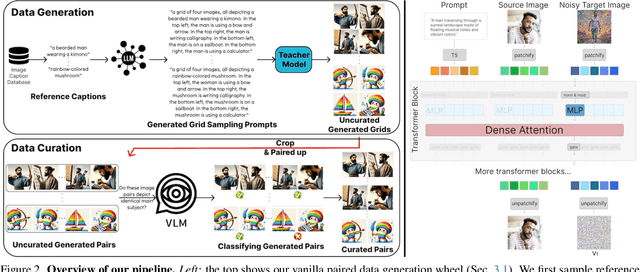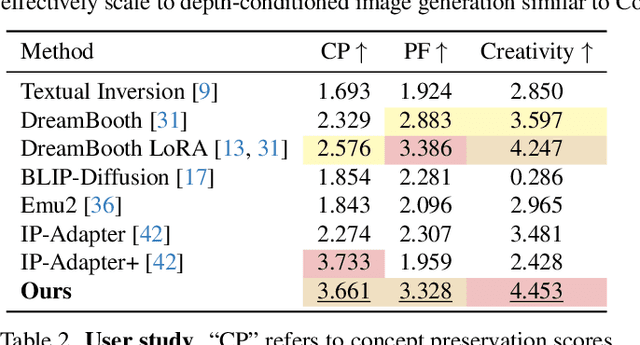Shengqu Cai
Mixture of Contexts for Long Video Generation
Aug 28, 2025Abstract:Long video generation is fundamentally a long context memory problem: models must retain and retrieve salient events across a long range without collapsing or drifting. However, scaling diffusion transformers to generate long-context videos is fundamentally limited by the quadratic cost of self-attention, which makes memory and computation intractable and difficult to optimize for long sequences. We recast long-context video generation as an internal information retrieval task and propose a simple, learnable sparse attention routing module, Mixture of Contexts (MoC), as an effective long-term memory retrieval engine. In MoC, each query dynamically selects a few informative chunks plus mandatory anchors (caption, local windows) to attend to, with causal routing that prevents loop closures. As we scale the data and gradually sparsify the routing, the model allocates compute to salient history, preserving identities, actions, and scenes over minutes of content. Efficiency follows as a byproduct of retrieval (near-linear scaling), which enables practical training and synthesis, and the emergence of memory and consistency at the scale of minutes.
Captain Cinema: Towards Short Movie Generation
Jul 24, 2025Abstract:We present Captain Cinema, a generation framework for short movie generation. Given a detailed textual description of a movie storyline, our approach firstly generates a sequence of keyframes that outline the entire narrative, which ensures long-range coherence in both the storyline and visual appearance (e.g., scenes and characters). We refer to this step as top-down keyframe planning. These keyframes then serve as conditioning signals for a video synthesis model, which supports long context learning, to produce the spatio-temporal dynamics between them. This step is referred to as bottom-up video synthesis. To support stable and efficient generation of multi-scene long narrative cinematic works, we introduce an interleaved training strategy for Multimodal Diffusion Transformers (MM-DiT), specifically adapted for long-context video data. Our model is trained on a specially curated cinematic dataset consisting of interleaved data pairs. Our experiments demonstrate that Captain Cinema performs favorably in the automated creation of visually coherent and narrative consistent short movies in high quality and efficiency. Project page: https://thecinema.ai
X-Dyna: Expressive Dynamic Human Image Animation
Jan 20, 2025Abstract:We introduce X-Dyna, a novel zero-shot, diffusion-based pipeline for animating a single human image using facial expressions and body movements derived from a driving video, that generates realistic, context-aware dynamics for both the subject and the surrounding environment. Building on prior approaches centered on human pose control, X-Dyna addresses key shortcomings causing the loss of dynamic details, enhancing the lifelike qualities of human video animations. At the core of our approach is the Dynamics-Adapter, a lightweight module that effectively integrates reference appearance context into the spatial attentions of the diffusion backbone while preserving the capacity of motion modules in synthesizing fluid and intricate dynamic details. Beyond body pose control, we connect a local control module with our model to capture identity-disentangled facial expressions, facilitating accurate expression transfer for enhanced realism in animated scenes. Together, these components form a unified framework capable of learning physical human motion and natural scene dynamics from a diverse blend of human and scene videos. Comprehensive qualitative and quantitative evaluations demonstrate that X-Dyna outperforms state-of-the-art methods, creating highly lifelike and expressive animations. The code is available at https://github.com/bytedance/X-Dyna.
Diffusion Self-Distillation for Zero-Shot Customized Image Generation
Nov 27, 2024



Abstract:Text-to-image diffusion models produce impressive results but are frustrating tools for artists who desire fine-grained control. For example, a common use case is to create images of a specific instance in novel contexts, i.e., "identity-preserving generation". This setting, along with many other tasks (e.g., relighting), is a natural fit for image+text-conditional generative models. However, there is insufficient high-quality paired data to train such a model directly. We propose Diffusion Self-Distillation, a method for using a pre-trained text-to-image model to generate its own dataset for text-conditioned image-to-image tasks. We first leverage a text-to-image diffusion model's in-context generation ability to create grids of images and curate a large paired dataset with the help of a Visual-Language Model. We then fine-tune the text-to-image model into a text+image-to-image model using the curated paired dataset. We demonstrate that Diffusion Self-Distillation outperforms existing zero-shot methods and is competitive with per-instance tuning techniques on a wide range of identity-preservation generation tasks, without requiring test-time optimization.
Collaborative Video Diffusion: Consistent Multi-video Generation with Camera Control
May 27, 2024Abstract:Research on video generation has recently made tremendous progress, enabling high-quality videos to be generated from text prompts or images. Adding control to the video generation process is an important goal moving forward and recent approaches that condition video generation models on camera trajectories make strides towards it. Yet, it remains challenging to generate a video of the same scene from multiple different camera trajectories. Solutions to this multi-video generation problem could enable large-scale 3D scene generation with editable camera trajectories, among other applications. We introduce collaborative video diffusion (CVD) as an important step towards this vision. The CVD framework includes a novel cross-video synchronization module that promotes consistency between corresponding frames of the same video rendered from different camera poses using an epipolar attention mechanism. Trained on top of a state-of-the-art camera-control module for video generation, CVD generates multiple videos rendered from different camera trajectories with significantly better consistency than baselines, as shown in extensive experiments. Project page: https://collaborativevideodiffusion.github.io/.
Generative Rendering: Controllable 4D-Guided Video Generation with 2D Diffusion Models
Dec 03, 2023Abstract:Traditional 3D content creation tools empower users to bring their imagination to life by giving them direct control over a scene's geometry, appearance, motion, and camera path. Creating computer-generated videos, however, is a tedious manual process, which can be automated by emerging text-to-video diffusion models. Despite great promise, video diffusion models are difficult to control, hindering a user to apply their own creativity rather than amplifying it. To address this challenge, we present a novel approach that combines the controllability of dynamic 3D meshes with the expressivity and editability of emerging diffusion models. For this purpose, our approach takes an animated, low-fidelity rendered mesh as input and injects the ground truth correspondence information obtained from the dynamic mesh into various stages of a pre-trained text-to-image generation model to output high-quality and temporally consistent frames. We demonstrate our approach on various examples where motion can be obtained by animating rigged assets or changing the camera path.
DiffDreamer: Consistent Single-view Perpetual View Generation with Conditional Diffusion Models
Nov 22, 2022Abstract:Perpetual view generation -- the task of generating long-range novel views by flying into a given image -- has been a novel yet promising task. We introduce DiffDreamer, an unsupervised framework capable of synthesizing novel views depicting a long camera trajectory while training solely on internet-collected images of nature scenes. We demonstrate that image-conditioned diffusion models can effectively perform long-range scene extrapolation while preserving both local and global consistency significantly better than prior GAN-based methods. Project page: https://primecai.github.io/diffdreamer .
Pix2NeRF: Unsupervised Conditional $π$-GAN for Single Image to Neural Radiance Fields Translation
Feb 26, 2022



Abstract:We propose a pipeline to generate Neural Radiance Fields~(NeRF) of an object or a scene of a specific class, conditioned on a single input image. This is a challenging task, as training NeRF requires multiple views of the same scene, coupled with corresponding poses, which are hard to obtain. Our method is based on $\pi$-GAN, a generative model for unconditional 3D-aware image synthesis, which maps random latent codes to radiance fields of a class of objects. We jointly optimize (1) the $\pi$-GAN objective to utilize its high-fidelity 3D-aware generation and (2) a carefully designed reconstruction objective. The latter includes an encoder coupled with $\pi$-GAN generator to form an auto-encoder. Unlike previous few-shot NeRF approaches, our pipeline is unsupervised, capable of being trained with independent images without 3D, multi-view, or pose supervision. Applications of our pipeline include 3d avatar generation, object-centric novel view synthesis with a single input image, and 3d-aware super-resolution, to name a few.
 Add to Chrome
Add to Chrome Add to Firefox
Add to Firefox Add to Edge
Add to Edge